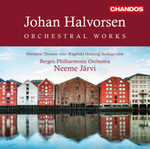|
Back
11/19/2014
‘Orchestral Works’
Johan Halvorsen: Bojarenes Indtogsmarsch – Andante religioso – Suite from ‘Mascarade’ – La Mélancolie – Symphonies N° 1 in C minor, N° 2 in D minor ‘Fatum’ & N° 3 in C major – Suite ancienne, Opus 31A – 3 Norwegian Dances – Air norvégien, Opus 7 – Chant de la Veslemöy – Sorte Svaner – Bryllupsmarsch, Opus 32, N° 1 – Rabnabryllaup uti Kraakjalund – Fossegrimen, Opus 21 – Bergensiana – Rhapsodies norvégiennes N° 1 & N° 2 – Brudefølget drager forbi – Passacaglia, Opus 20, N° 2 – Dance Scene from ‘Queen Tamara’ – Symphonic Intermezzo from ‘The King’ – Norsk Festouverture, Opus 16 – Norsk Eventybilleder, Opus 37
Marianne Thorsen (Violin), Ragnhild Hemsing (Hardanger fiddle), Melina Mandozzi (Violin), Ilza Klava (Viola), Bergen Philharmonic Orchestra, Neeme Järvi (Conductor)
Recording: Grieghallen, Bergen, Norway (August 24-September 2, 2009, September 1, 2010 & August 22-23, 2011) – 306’30
4-Disk Set Chandos Digital # CHAN 10834(4) (Distributed by Naxos of America) – Booklet in English, German, French

   
Violinist-turned-concertmaster-turned-conductor, energetic Johan Halvorsen widely created entr’acte and incidental music for the theater, his core attuned to those conventions of Edvard Grieg, yet with a style that reached beyond Frontières norvégiennes with flits of international flair. This Chandos collection fitfully explores the immensity of Halvorsen’s library, deftly played by the Bergen Philharmonic Orchestra under the sensibilities of Neeme Järvi.
One of his best known works, the Bojarenes Indtogsmarsch (Entry March of the Boyars), inspired by a trip to Bucharest, Romania (the city’s Conservatory granted Halvorsen the position of Professeur supérieur, but he turned it down), opens the album. Possessive of an exuberant personality might help explain the dramatic shifting of mood and tempo (i.e. symphonies and rhapsodies) even within movements. Halvorsen’s music infuses arctic freshness that seldom lacks complacency.
Since Halvorsen’s instrument of choice was the violin, it comes as no surprise this orchestra staple plays an important role in his compositions including viola and the extant Hardanger Fiddle (hardingfele)(c. 1600.) Notable winner of several competitions, Marianne Thorsen displays her dexterities as she creates beautifully sweeping lines in the premiere recording of Andante religioso, but where she especially shines is in the Bryllupsmarsch (Wedding March) as her bowstring bounces magically off the strings to create the springer effect, so commonly found within the Scandinavian country’s dance melodies.
Equally nimble is the repartee inside the popular Passacaglia featuring the talents of Melina Mandozzi on violin and Ilze Klava on viola. This piece, based on the Passacialle (Chaconne) from Handel’s Suite N° 7 in G minor, HWV 432 for harpsichord, evenly matches the two against the 16-plus variations in just over seven minutes’ time, a composition that becomes more and more blurred from Handel’s foundational values as the piece progresses.
One of the unique instruments indigenous to Norway is the Hardanger fiddle with its distinguishable “droning” sounds. This multi-layered stringed quasi violin lays important groundwork for the Fossegrimen (1905), a dramatic suite that Halvorsen penned for Sigurd Eldegard’s ‘troll-play in four parts.’ The movement’s opening (“Allegro moderato”) subtly flickers with harp that soon unveils Ragnhild Hemsing’s dazzling returns on the fiddle. At times set in ¾ time, Hemsing dominates in lyrical melody, yet she also “dialogues” with other instruments. The marked tone is set in this section, and even the closing remarks beat with cinematic qualities with a final say from the harp and fiddle. As a counterpoint to “Auds Sang” (“Aud’s Song”), the “Huldremøyarnes Dans” waltz-stepping is idyllic and soothingly pleasant.
With my personal roots steeped near the Hardanger region, the “Breremarsch” is quite nostalgic, and marks the musical epitome of Norwegian folk dance. The piece is replete with indelible halling rhythms, conjuring images of Hemsing delicately hopping atop the Jostedalsbreen Glacier. The colouring and flavoring couldn’t be better. Once again, the ensuing “Danse visionaire” (now officially omitted) begins with blinks from the harp only to continue in melody that has the flouncing of “Anitra’s Dance” from Peer Gynt (1874). There’s even brevetting spouts of Rosenkavalier sparkle and a couple quick moments that an acute listener will discern must have landed on Halvorsen’s pages from “Song to the Moon” from Rusalka (1901). Melina Mandozzi’s violin expresses with agilité extrordinaire.
Regarded as Halvorsen’s best of his three symphonies, the Symphony N° 2 ‘Fatum’ is grounded in D minor with a fate dimension that brings Beethoven or Tchaikovsky to mind. A beautiful oboe cantilena opens the second movement’s “Romance.” The subsequent “Intermezzo” elicits a lilting Norwegian dance beat that is subjugated by gavotte (1:05) sequences for only a few brief seconds. Woodwinds wind their way into Halvorsen’s notes that bear resemblance to Carmen’s “Danse bohémienne.”
Other mentions: The “Passepied” from Johan Halvorsen’s Suite from ‘Maskarade’ is a distant personification to Act III’s (“Cours-la-Reine”) “Entr’acte” from Massenet’s Manon while a Delius factor is calculated inside Symphony N° 1’s “Andante.” Halvorsen’s arrangement of Brudefølget dragger forbid (Norwegian Bridal Procession) retains a generally lighter fare yet heavier on the woodwinds when compared to Grieg’s original version. Järvi and his musical compatriots paint this picture with a rather brisk tempo (personally too brisk for me, however.)
Closing this compendium remain three interesting and differing textures: the Dance Scene from ‘Queen Tamara’ was inspired during Halvorsen’s visit to the Asian steppes, and it brings with it texture oriental and distant infusions from “Procession of the Sardar” from Mikhail Ippolitov-Ivanov’s Caucasian Sketches (1894); the Symphonic Intermezzo from ‘The King’ is a tone poem of sorts with its Lisztian and Wagnerian qualities.
This commentary is abbreviated, but, on balance, Chandos does a superior job in bringing the works of Johan Halvorsen more prominence. Sound quality is excellent. If one savors in the Norwegian musical richness of Johan Svendsen, Edvard Grieg, and Christian Sinding, then look into this remarkable album.
Christie Grimstad
|